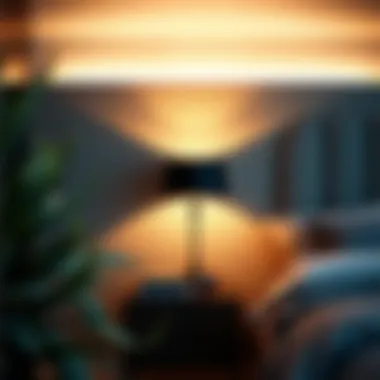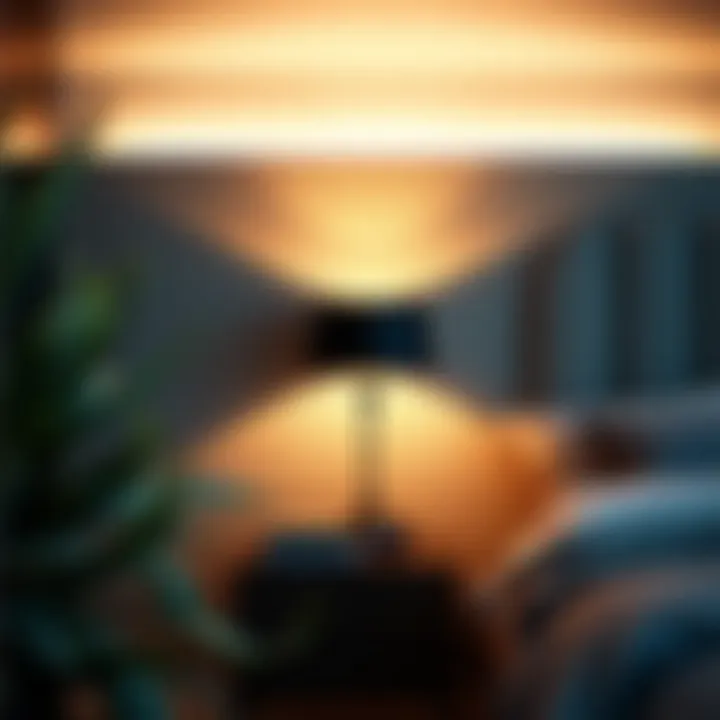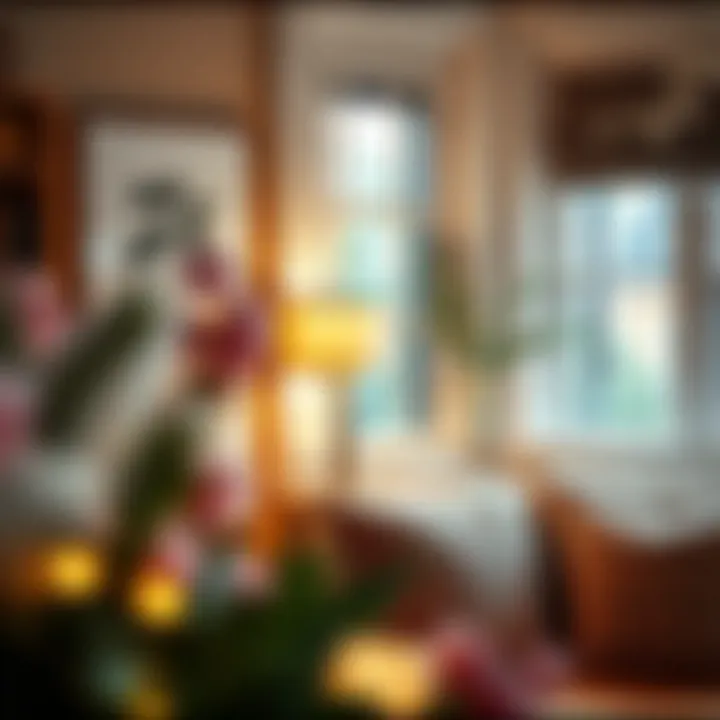Essential Guide to Nightstand Lamp Sets


Intro
Selecting the perfect nightstand lamp set is more than just picking a source of light; it's about crafting an ambiance, enhancing decor, and adding function to one's personal space. This thoughtful choice can transition a room from bland to breathtaking in the blink of an eye. When considering nightstand lamps, there's a blend of practicality and aesthetics that comes into play. Some lamps are chosen for their glow, while others serve as striking design statements. Readers will find that understanding lamp styles, their functional roles, and the art of placement creates an overall atmosphere that signals comfort and taste.
Furniture Styles and Trends
Exploring Popular Furniture Styles
In the realm of interior design, the choice of furniture style is paramount. Each year, designers and homeowners alike lean on various trending styles, and nightstand lamps are no exception. From minimalist Scandi vibes with clean lines to the lush elegance of Art Deco, each style carries distinct characteristics.
- Modern: Characterized by simplicity and functionality, modern lamps boast sleek appearances and often utilize metals and glass.
- Traditional: Features elaborate designs, intricate carvings, and rich materials like brass or wood, typical of classic aesthetics.
- Industrial: Raw metals and Edison bulbs combine to give lighting a rugged appearance, often paired with wood or concrete furniture.
- Bohemian: An eclectic mix of colors, patterns, and textures, boho lamps draw from various cultures, showcasing a well-traveled vibe.
Understanding the nuances of each style can help make a more informed decision about which lamp complements existing furniture.
Understanding Current Design Trends
Trends shift constantly in the world of home decor, and lamps are often the unsung heroes in this transitional landscape. Observing current design trends offers insight into what styles are gaining traction. With sustainability at the forefront of many minds, eco-friendly designs are increasingly popular. Lamps made from upcycled materials or energy-efficient bulbs cater to this rising consciousness. A current favorite is the use of smart lighting, where LED lamps can adjust tone and brightness based on the time of day or personal preference.
"The right lighting can be the difference between a house that feels lived-in and one that feels unloved."
In addition, brass finishes are making a comeback, showcasing warmth and vintage appeal. The fusion of art with function is also on the rise. Lamps now serve as statement pieces, not merely functional items. As trends evolve, it’s wise to keep an eye on the latest designs to create an inviting and up-to-date atmosphere in your bedroom.
Practical Tips for Furniture Selection
Factors to Consider When Choosing Furniture
When it comes to selecting nightstand lamp sets, several key factors should inform your decisions:
- Height: The ideal lamp height should align with your bed’s mattress height, allowing easy reach when turning off the light.
- Light Quality: Choose between various bulb types, like LED or incandescent, as these can influence the feel of the light significantly.
- Style Cohesion: Ensure lamps complement the overall decor of the room and align with other furnishings.
- Functionality: Some lamps come with built-in USB ports, enabling charging capabilities while maintaining a sleek look.
How to Measure and Optimize Space
Maximizing space is crucial in any bedroom layout. Taking proper dimension measurements is vital to ensure lamps fit well on nightstands without overcrowding. Here are some tips to optimize your layout:
- Measure the nightstand beforehand, ensuring lamps are proportional to the size.
- Consider the distance from the wall to avoid shadows or blockages.
- Keep lamp shades about 1.5 to 2 times the width of the base to maintain balance visually.
Finding the right nightstand lamp set is a blend of understanding styles, trends, and personal needs. These choices shape a comforting, stylish environment that echoes one's personality.
Understanding Nightstand Lamp Sets
Nightstand lamp sets are pivotal in crafting a bedroom's atmosphere. They serve not only as a source of illumination but also as essential design elements that can tie the decor together. Understanding these lamp sets involves diving into their definitions, functionality, and how they influence overall bedroom aesthetics.
Definition and Functionality
Nightstand lamp sets typically consist of lamps designed to be placed on bedside tables, often in pairs, although they can also be arranged in varying configurations. These lamps provide localized light for activities like reading or using a smartphone before sleep. Routine tasks become more manageable with a proper lamp set, ensuring you don't have to fumble around in the dark. The functionality goes beyond mere lighting. Modern nightstand lamps often incorporate features such as dimmers or integrated USB ports, which add a layer of utility that aligns with contemporary needs. As homes become more multifunctional, the relevance of smart technology integrated into lighting solutions cannot be overlooked, ensuring accessibility and ease of use.
Importance in Bedroom Design
When considering bedroom design, the significance of nightstand lamps cannot be underestimated. They influence not just the light quality but also the room's visual balance and style. A mismatched lamp can throw off the entire aesthetic, while a well-chosen set can make the space feel cohesive. Beyond appearance, the right lamps can introduce warmth or coolness to a room, impacting mood and comfort. For instance, warmer bulbs can soften a space, creating a cozy vibe, whereas cooler tones can lend a more energetic feel. Moreover, strategically placed lamps highlight or obscure architectural features, giving designers a tool to manipulate spatial perception effectively.
Key Design Elements
Several key design elements characterize nightstand lamp sets. These include:
- Style: From minimalistic to ornate, the lamp style should reflect the overall design theme of the bedroom.
- Height: The size of the lamps relative to the nightstand and bed height impacts usability and design flow.
- Shade Shape: The lamp shade influences light diffusion and style. A wider shade can provide more spread of light, while a narrow one focuses the illumination.
- Material Choices: Choices from metal to ceramic can significantly affect the sentiments conveyed in the space. A glass lamp offers elegance, while wooden lamps bring warmth.
- Color Considerations: Color choices can either blend with existing decor or provide a striking contrast that captures attention through savvy use of contrast.
Each of these elements works together to create a harmonious or deliberately dissonant look, depending on the homeowner's intent. Understanding these factors is essential for homeowners and designers alike, allowing them to select or create nightstand lamp sets that complement their vision effectively.
"The right nightstand lamp not only illuminates your space but also enhances the beauty and functionality of your bedroom."
Types of Nightstand Lamps
When it comes to nightstand lamp sets, selecting the right type is essential to achieving both functionality and aesthetic appeal. Nightstand lamps aren’t just sources of light; they're integral to the overall vibe of a bedroom. They can set the mood for relaxation or provide bright illumination for reading and other activities. This section will explore the three primary types of nightstand lamps: table lamps, wall-mounted lamps, and floor lamps, analyzing their unique benefits and considerations.
Table Lamps
Table lamps are perhaps the most common choice for nightstands. They come in various styles, heights, and designs, making them dynamic pieces for any bedroom decor. The flexibility of table lamps allows homeowners to easily switch styles without committing to major renovations or redecorations.
For instance, if you think of a cozy reading nook beside the bed, a table lamp can provide adequate lighting without overpowering the space. Select lamps with adjustable brightness settings to suit different tasks, whether you're basking in the soft glow while flipping through pages of a novel or needing more light to locate that pesky book on the shelf.
An essential factor to consider is the height of the lamp. Ideally, the bottom of the lampshade should be at eye level when seated. This helps avoid glare while providing optimal light direction. A smart move would be to choose table lamps with complementary shades and bases to your overall bedroom theme, ensuring harmony throughout the space.
Wall-Mounted Lamps
If floor space is at a premium or if you favor a sleek, modern design, wall-mounted lamps can be a game changer. They free up valuable bedside real estate by attaching directly to the wall. This type can be a striking design element while providing practical illumination.
For those who wish to incorporate unique styles, wall-mounted lamps come in various forms, such as sconces or swing-arm designs, which can be adjusted to direct light precisely where it's needed.
Additionally, the sheer versatility of wall-mounted lamps can be highlighted when placed behind headboards or along the bedside, giving a feeling of depth and layering to the room. An often-overlooked advantage is how they can act as focal points in the decor, drawing the eye upward and contributing to the room’s compositional balance.
Floor Lamps as Alternatives
Floor lamps, while less common on nightstands, offer a distinct alternative for lighting. Positioned beside the bed, they can illuminate larger areas by casting light from above, creating a spacious atmosphere. Some types even double as reading lights, featuring adjustable arms or shades that allow further customization.
These lamps work particularly well in spacious or eclectic bedroom settings. They add height and visual interest, contrasting nicely with the more compact elements like nightstands or beds. A well-placed floor lamp can even serve as a standalone feature, enhancing the room's overall character.
However, when choosing a floor lamp, consider your room's scale. An oversized floor lamp in a cramped space might feel overbearing, while a delicate design may look dwarfed in wider expanses.
"Choosing the right type of nightstand lamp is like finding the perfect accessory for your outfit—it can tie together the entire look of the room."


Selecting the right type of nightstand lamp will significantly affect not just the functionality of your space but its emotional resonance as well. Understand your room’s needs and style, and choose lamps that speak to those elements. Consider making a choice based on your lifestyle and how you use your space, rather than merely on trends. Each of the lamp types discussed brings something valuable to the table, or in this case, the nightstand.
Choosing the Right Style
When it comes to nightstand lamp sets, the style you choose can significantly alter both the function and aesthetics of the bedroom. Paying close attention to your lamp's design is not merely about personal taste; it influences how the space feels and operates. Selecting a lamp that resonates with your overall design scheme enhances the harmony of the room, creating a sanctuary of relaxation and beauty. Additionally, the right stylistic choices can reflect individual character and ensure the night's rest is as effective as possible.
Modern Aesthetics
Modern aesthetics in lamp design hinge on clean lines, minimalism, and functionality. Think of lamps that are not just light sources but art pieces blending seamlessly into the bedroom decor. Fixtures with geometric shapes and materials like glass and metal fulfill both functional and decorative roles.
Consider a lamp with sleek contours, perhaps a brushed steel finish paired with a simple linen shade. This design doesn't just provide light; it acts as a conversation starter. Imagine waking up to a subtle glow that complements a contemporary artwork on the wall or a stylish bedspread.
- Simplicity: Emphasizing functionality while steering clear of unnecessary ornamentation allows for versatility across various design schemes.
- Color Palettes: Neutral tones combined with pops of color can help maintain a fresh vibe.
- Transparency: Glass or acrylic bases can create an illusion of space, which is particularly beneficial in smaller bedrooms.
Classic Designs
Classic designs, embodying timeless elegance, present an entirely different approach to lamp choice. From ornate bases with intricate details to rich color hues, these lamps tell a story of tradition.
Imagine a brass lamp highlighting old-world craftsmanship, topped with a warm-toned fabric shade. Such a selection not only adds warmth but can also fuse seamlessly with antique furniture or vintage decor.
- Material Choices: Typical materials here include ceramic, metal, and various fabrics.
- Shapes: Curvy bases and vintage silhouettes often lend an air of sophistication and charm.
- Color: Deep hues like navy or burgundy can provide a dramatic accent, inviting a cozy atmosphere that is hard to resist.
Choosing a classic lamp right can make the bedroom feel like a warm embrace, perfect for winding down after a long day.
Eclectic Varieties
Eclectic styles offer the most creative freedom, drawing from an array of influences that can range from bohemian to industrial chic. This allows you to play with unexpected combinations that can reflect personal travels, artistic phases, or even spontaneous whims.
For instance, a patterned ceramic lamp juxtaposed against streamlined furniture can create an intriguing visual balance. Choosing different lamp styles throughout your nightstand setup can reinforce your individuality and spark creativity.
- Combining Patterns: Mixing various patterns, textures, and colors can break monotony, creating an inviting feel.
- Unique Sourcing: Vintage shops, flea markets, or artisan websites can provide one-of-a-kind lamps that reflect a personal journey.
- Visual Balance: Ensure that even paired together, eclectic lamps maintain a sense of visual equilibrium, which keeps the room feeling cohesive.
In summation, regardless of the style you lean toward, the nightstand lamp set serves more than just a functional purpose—it reflects a multi-faceted approach to design that can transform an ordinary room into an extraordinary haven.
"Style is a way to say who you are without having to speak." - Rachel Zoe
By aligning your nightstand lamp choices with your bedroom's overall aesthetic, you not only enhance its beauty but also its functionality. So take your time, explore various options, and let your lamps tell your story.
Light Quality and Its Significance
When it comes to creating a comfortable and inviting bedroom, the quality of light is paramount. It's not simply about illumination; it's about the atmosphere that light brings into the space. The right lighting can turn a mundane room into a haven of tranquility. This section delves into the significance of light quality, exploring how it plays into bedroom aesthetics, functionality, and overall well-being.
Choosing lamps involves more than just picking out a pretty shade. The interplay between light and design directly affects how we perceive our space and influences our moods. Quality light can enhance relaxation, promote better sleep, and even brighten up dark corners that may otherwise feel claustrophobic. For homeowners and interior decorators alike, understanding light quality is essential to creating a harmonious environment.
Understanding Color Temperature
Color temperature, measured in Kelvin, refers to the hue of the light emitted by a bulb. On the spectrum of light, this can range from a cool, bluish-white light at the high end—typically around 5000K to 6500K—to a warm, cozy glow at the lower end, around 2700K to 3000K.
Here’s how it affects your space:
- Cool Light (Above 4000K): Great for productivity. Ideal for workspaces or if you want to give your room a modern, vibrant feel.
- Neutral Light (3500K - 4000K): Strikes a balance between warmth and coolness, often used in transitional spaces.
- Warm Light (Below 3000K): Creates a soft atmosphere. This is what makes a bedroom feel inviting and cozy, encouraging relaxation.
In a bedroom setting, it’s generally advisable to lean towards warmer tones, as they create a soothing environment conducive to winding down.
Importance of Lumens
Lumens measure the brightness of light emitted by a bulb. The general rule of thumb is that more lumens mean a brighter light, which can be beneficial or detrimental depending on context.
Here’s how to find the right balance:
- Ambient Lighting: This is the overall light level in the room; typically, aim for about 200-300 lumens per square meter.
- Task Lighting: For specific activities like reading or writing, you’ll want around 400-800 lumens directed at the task area.
- Accent Lighting: Lower lumens, anywhere from 100 to 300, can be used effectively to highlight decor or specific features of the room, enhancing aesthetics.
By ensuring a good balance of lumens, you can control the mood and functionality of your space, proving why it’s an essential aspect of light quality.
Choosing Bulbs Wisely
Bulbs come in various types—LEDs, incandescents, halogens, and fluorescents—each with unique characteristics that influence light quality.
- LED Bulbs: These are the front runners in energy efficiency. They last longer and offer a wide range of color temperatures, suitable for different needs.
- Incandescent Bulbs: While they produce warm light, they are less energy-efficient and may not last as long as other types.
- Halogen Bulbs: They provide bright, white light and excellent color rendering, making them suitable for accent lighting. However, they tend to generate more heat.
- Fluorescent Bulbs: These are best for task lighting and are generally used in offices or kitchens due to their brightness but can feel harsher in a bedroom setting.
Before deciding on the bulb, consider the room’s purpose and how you want it to feel. Not only can the right choice enhance the room’s look but it can also contribute to your overall mood and well-being.
"Lighting is a vital tool—choose wisely, and you shape your space into a sanctuary."
Understanding the elements of light quality—color temperature, brightness, and bulb selection—can truly transform nighttime routines and elevate how you experience rest and relaxation in your personal haven.
Spatial Arrangement Considerations
When thinking about nightstand lamp sets, one might easily overlook the spatial arrangement aspect, but it's a critical piece in the puzzle. Proper arrangement of lamps not only enhances the functionality of the bedroom but also significantly contributes to the overall aesthetic appeal. It's not just about having a lamp on your nightstand; it's about where that lamp sits in relation to everything else. Get it right, and you've set the stage for a cozy, well-designed space.
Height and Placement
The height and placement of nightstand lamps can profoundly affect how they serve your daily routines. A lamp that’s too tall could overshadow your bedside reading, casting an unwanted shadow over your pages, while something too short may leave you squinting in the dim light. Ideally, the bottom of the lampshade should sit at or just below eye level when you are seated on the bed. This positioning ensures that the light is directed where you need it most.
Consider the height of your nightstand too. Is it a standard design, or is it an awkward piece that hinders light flow? If you have a higher bed, a taller lamp might be in order. On the flip side, a dainty table may pair better with a more modest fixture. Depending on your decor style, this choice can also affect the room’s visual weight and balance. A towering lamp in a compact space can dwarf its surroundings, creating an uncomfortable feel.
Proximity to Bedside Necessities
Just as a chef needs their utensils within arm's reach, you should consider how close your lamp sits to other essential items on your nightstand. This could be books, a phone, water, or even reading glasses. Having everything within easy reach reduces clutter and increases efficiency. If you're the type who reads in bed, make sure the lamp isn’t just there for show; it should illuminate your book without you having to juggle about.
Also, reflect on the orientation of the lamp relative to the bed. A lamp that’s too far away may make it an inconvenience to turn it on without getting out of bed, especially in those early morning hours.


"A lamp isn't just a source of light; it's the choreographer of your nightstand’s performance—a master at creating ambiance while keeping everything in check."
Navigating Space Limitations
Not everyone has the luxury of expansive bedside tables. When dealing with tighter spaces, creativity becomes the name of the game. Consider wall-mounted lamps as an alternative. They can save precious table space while still providing the necessary light. These fixtures can be placed at various heights, allowing you additional versatility in your arrangements.
If you can't mount a lamp, think about nesting smaller lamps or even stacking them slightly off the edge of the table. Keep the larger, more cumbersome items towards the back. This strategy keeps the visual focus on the lighting and makes better use of the available space without compromising style.
In the end, navigating spatial limitations requires a keen eye for design and an understanding of functionality. Not every arrangement will suit your needs, but experimenting with placement may just uncover a sweet spot that transforms your nightly rituals.
Material and Finish Options
Selecting the right material and finish for nightstand lamp sets is not just about striking a visual harmony within your bedroom; it also involves understanding how various materials can enhance functionality, durability, and aesthetics. Each alternative presents unique benefits and potential drawbacks that cater to diverse style preferences and practical needs. The choices you make profoundly impact not only the look of your space but also the longevity and usability of the lamp itself.
Metal Finishes
Metal finishes in nightstand lamps bring a sense of modernity and sophistication. Factors like sheen, color, and texture play a pivotal role in how metal interacts with other bedroom elements. For instance, brass or gold finishes offer a touch of vintage charm, while matte black or brushed nickel aligns well with contemporary designs. Choosing metal finishes should reflect your intended mood—shiny surfaces reflect light beautifully, adding brightness and liveliness, whereas darker hues provide a more subdued, intimate ambiance.
"The finish of a lamp isn’t just a cosmetic trait; it shapes how light disperses and interacts within the room."
Some popular metals include:
- Brass: Warm and inviting, often used in traditional designs.
- Stainless Steel: Sleek and minimalistic, great for modern and industrial themes.
- Aluminum: Lightweight and versatile, perfect for those who like experimenting with lamp shapes.
When deliberating on metal finishes, consider how well they pair with existing furnishings. For instance, a polished chrome lamp can effortlessly elevate a collection of wooden nightstands. The key is to find that balance—a metallic touch can either blend seamlessly or create a striking focal point, depending on your approach.
Wood Accents
Wooden accents in lamp sets evoke a sense of warmth and coziness, establishing a connection to nature. Options range from rich mahogany to rustic pine; each has its unique grain patterns and natural variations. This variety allows homeowners to choose designs that reflect their personal style—be it sleek and refined or rustic and homey.
While considering wood accents, pay attention to factors that influence the wood's performance, such as:
- Durability: Hardwoods like oak or maple stand the test of time.
- Finish: A matte finish vs. a glossy finish can alter the overall vibe.
- Eco-friendliness: Seek out sustainably sourced woods to make an environmentally conscious decision.
Wooden lamps can also serve as conversation starters. They can add textural contrast to a predominantly metal or fabric-styled space, making them ideal for those who appreciate depth in design.
Fabric Lampshades
Fabric lampshades introduce a myriad of design possibilities. Their soft texture diffuses light gently, creating a warm glow that enhances relaxation. Various fabrics, such as linen, silk, or burlap, each manifest different aesthetics and light qualities.
Important considerations for fabric lampshades include:
- Color: A lighter shade can brighten a dim space, while darker fabrics can make a bold statement.
- Pattern: Choosing patterned fabric can add a playful or elegant element to the decor, depending on the design.
- Maintenance: Fabric can attract dust or stains, so consider options like removable covers for easy cleaning.
With the right fabric, one can layer textures and create inviting environments. A delicate silk shade paired with a wooden base can blend luxury with organic warmth, whereas a vibrant patterned shade could infuse a splash of personality into a minimalist setup.
Innovations in Lamp Technology
In recent years, the world of lighting has taken significant strides, leaving traditional bulbs in the dust. With the rise of technology, nightstand lamp sets have undergone a remarkable transformation, making them not just functional, but also smart and energy-efficient. Innovations in lamp technology elevate the user experience in ways that were once just a figment of imagination. Understanding these advancements is essential for homeowners and interior designers looking to create the perfect ambiance in a bedroom.
Smart Lighting Solutions
Smart lighting solutions have redefined the way we interact with our lamps. These are not just about turning them on or off anymore; they come packed with features that allow for remote control and automation. Picture this: you're snug in bed, and rather than getting up to flick the switch, you pull out your smartphone or simply speak a command.
- Voice Control: Many smart lamps now integrate with devices like Amazon Alexa or Google Assistant, making life a whole lot easier.
- Customizable Settings: Users can set pre-defined lighting moods for various activities like reading, relaxing, or sleeping. Such customization means one can have warm white light for bedtime and bright light when reading.
- Scheduling Features: You can schedule your lamps to turn on at specific times. This feature not only enhances convenience but also serves as security by simulating presence in the home.
Energy Efficiency Considerations
The push for energy efficiency is becoming a necessity in our eco-conscious society. Nightstand lamps utilizing LED technology can significantly reduce energy consumption, which translates to lower electricity bills. But it’s not just about cost savings; it’s about selecting the right products.
Advantages of energy-efficient lamps:
- Long Lifespan: LED bulbs can last up to 25,000 hours or more, which means fewer replacements and less waste.
- Less Heat Production: Unlike traditional incandescent bulbs, LEDs generate minimal heat. This is a significant benefit in terms of safety and comfort, especially in a cozy bedroom setting where warmth can be counterproductive.
- Reduced Carbon Footprint: By opting for energy-efficient lighting solutions, one contributes to a more sustainable environment.
Adaptive Lighting Features
Adaptive lighting is catching on fast, adding another layer of utility to nightstand lamps. This technology adjusts the lighting based on the environment and user preferences. Here’s how it makes a difference:
- Circadian Rhythm Support: Some lamps can adjust their color temperature throughout the day, promoting better sleep patterns. Morning light can be brighter and cooler, while evening light transitions to softer, warmer tones.
- Light Sensors: These sensors can automatically adjust the brightness based on ambient light levels, ensuring that the lighting is just right, whether it's day or night.
- Personalized Experience: Users can fine-tune their lighting experience depending on their mood or activity, which is extremely beneficial for creating a conducive environment for sleep, work, or relaxation.
"Innovations in lamp technology not only enhance functionality but also significantly impact energy consumption and personal comfort."
Customizing Your Nightstand Lamp Set
Customizing your nightstand lamp set is not just about slapping down a couple of bulbs on your side tables; it’s more akin to curating a personal piece of art that complements and enhances your sleeping quarters. When you take the reins to tailor your selection, you're opening the door to a myriad of benefits—stylistic expression, functional enhancement, and even emotional satisfaction. It’s about finding that delicate balance between what works visually and what serves you practically, so let’s break it down.
Mixing and Matching Styles
Mixing and matching styles can transform a banal bedroom into something that feels tailored just for you. Picture this: you have a mid-century lamp juxtaposed against a sleek contemporary nightstand. It's a juxtaposition that tells a story. However, there’s an art to making this work without resembling a jumbled flea market.
When combining different styles, consider these tips:
- Balance is Key: If you’re incorporating an ornate, vintage lamp, perhaps counter it with a minimalist nightstand. The goal is to marry contrasting elements to create a cohesive story rather than chaos.
- Limit Your Palette: Stick to just a few styles to avoid visual overload. Too many influences can create a cacophony of design.
- Use Common Elements: Shared materials or colors can tie disparate styles together nicely. For example, a brass lamp can match brass drawer pulls on your nightstand, creating unity.
This approach can serve as a brilliant conversation starter while reflecting your personal aesthetic.
Color Coordination
Color is a significant factor in any design endeavor, and your nightstand lamp set should not be an exception. A well-coordinated color scheme can not only make your room feel more pulled-together, but it can also affect your mood and overall ambiance. Choosing the right colors is like painting a canvas; it has to resonate well to evoke the right feelings.


Here are some things to keep in mind:
- Complementary Colors: Think about colors that naturally go together and enhance each other. For instance, soft blues with warm yellows can balance the cool of the blue with the warmth of the yellow.
- Accent vs. Neutral: If your lamp features a bold hue, like cobalt blue, consider keeping other elements more subdued to avoid clashing. Pastel shades can work well as a backdrop for colorful lamps, providing balance.
- Trendy or Timeless: Trends come and go; consider choosing a base color for your room that stands the test of time while allowing your lamps to radiate fashionable colors.
The art of color coordination keeps interiors feeling fresh—it's like setting the mood with a melody, subtle yet impactful.
Functional Adjustments
Functionality is another critical aspect that should not be overlooked when customizing your nightstand lamps. This isn’t just about aesthetics; these choices can have a real impact on your daily life. Here are a few practical adjustments you might consider:
- Bulb Types: Depending on your needs, you may want to consider options like LED bulbs for their longevity or smart bulbs that allow you to control the lighting through your smartphone. This is especially helpful for those night-time bookworms who want the right light without disturbing their partner’s slumber.
- Adjustable Features: Some lamps come with adjustable arms, or even dimming functions, which let you change the ambiance based on your needs. An adjustable lamp can work wonders whether you're reading a novel or winding down for sleep.
- Size Considerations: Ensure that your lamp is not too large for your nightstand and that it provides adequate light. The base shouldn’t overpower the table, and the lampshade should diffuse light effectively.
By focusing on functional adjustments, you ensure that your nightstand lamps are not just pretty faces, but rather functional pieces that enhance your lifestyle.
Maintenance and Care for Lamp Sets
When it comes to nightstand lamp sets, much like any cherished item in your home, maintenance and care play a crucial role in sustaining their aesthetic and functional value. Not only do properly maintained lamps elevate the bedroom's overall design, but they also ensure they continue to provide the light you need for reading or relaxation. Ignoring the care of these functional fixtures can lead to wear and tear that diminishes their beauty and performance over time. Below we dig into the practical aspects of caring for your nightstand lamps, covering cleaning techniques, the necessity of regular bulb replacements, and tips to avoid damage to finishes.
Cleaning Techniques
Keeping your nightstand lamps clean is essential, but surprisingly simple. Dust and grime accumulate quickly, and if left unattended, can affect both the light quality and the appearance of your lamp. Here are some helpful pointers:
- Regular Dusting: Periodically dust your lamps using a soft, dry cloth. Microfiber cloths are exceptional for avoiding scratches. This simple act can do wonders to maintain the lamp’s shine.
- Deep Cleaning: For lampshades, especially fabric ones, a gentle vacuum with a brush attachment can help remove dust. In the case of glass or metal parts, a damp cloth with mild soap will suffice. Ensure to avoid submerging lights in water—this is a sure way to create a mess!
- Avoid Harsh Chemicals: Steer clear of ammonia or bleach-based cleaning products. They can damage both the lampshade and the finish of your lamp. A little soap and water go a long way.
A clean lamp not only looks good but also enhances the quality of light you experience in your space.
Regular Bulb Replacement
Bulb replacement isn't just about ensuring you have light when you need it; it’s also about preserving the integrity of your lamp set. Over time, bulbs can dim or burn out, impacting the visual appeal and utility of the lamp. Here's why regular replacements are vital:
- Optimal Light Quality: Using fresh bulbs ensures the brightness you rely on, especially at night when you’re diving into a good book or enjoying a quiet space.
- Preventing Damage: An overworked bulb can generate excess heat, potentially leading to fixture damage. Regularly checking and changing bulbs helps prevent this unnecessary risk.
- Choose the Right Bulb: Don’t forget about energy efficiency! Consider switching to LED bulbs, which not only last longer but also save energy, allowing you to keep that cozy ambiance without increasing utility bills.
Avoiding Damage to Finishes
Understanding how to avoid damaging the finishes of your nightstand lamps is critical to maintaining their charm. Whether your lamps have a sleek metallic sheen or a rustic wood finish, treating them with care makes all the difference:
- Use Coasters: If your lamp base is made of wood or has a delicate finish, placing coasters underneath can help prevent scratches and water damage from common bedside items like drinks or skincare products.
- Temperature Awareness: Ensure that lamps aren’t too close to heat sources like radiators or open flames, since extreme temperatures can warp or discolor finishes.
- Store Properly When Moving: If you ever find the need to move your lamps—whether it’s for cleaning or rearrangement—do so with care. Use soft coverings to protect them from scratches.
Taking the time to care for your nightstand lamps really pays off, both in terms of aesthetics and longevity. Sound practices like cleaning regularly and replacing bulbs when needed, will ensure these lamp sets remain not just functional, but beautiful elements of your bedroom. Providing consistent care not only preserves their quality but also enhances your living space, adding both light and life to your home.
Sources of Inspiration
Exploring nightstand lamps can be a delightful journey, but knowing where to gather inspiration can make this task less daunting. The sources of inspiration shape an individual's decisions, especially when it comes to selecting the right lamp set for a bedroom. This section emphasizes diverse avenues that can spark creativity and provide valuable insights.
Interior Design Magazines
Interior design magazines offer a wealth of ideas and trending styles that can inform your choices when selecting nightstand lamp sets. Flipping through the pages, you can find various lamp designs ranging from minimalistic to ornate. Magazines such as Elle Decor and Architectural Digest often showcase beautifully styled rooms, allowing readers to see how different lamp styles complement various décor.
These publications serve a dual purpose: they are informative but also visually captivating.
Benefits of utilizing interior design magazines include:
- Visual Guidance: They provide snapshot examples of stylish arrangements and allow for easy visualization of how a certain lamp might fit into your room's design.
- Trend Awareness: Readers quickly get in tune with what’s currently in vogue, which is especially beneficial for homeowners looking to refresh their spaces.
Receiving inspiration from the glossy pages can help streamline your choices while revealing the endless possibilities that nightstand lamps bring to your bedroom.
Online Platforms and Communities
In the current digital age, online platforms and communities are treasure troves for anyone seeking inspiration. Websites like Pinterest and Instagram allow users to search for various design ideas quickly and interact with others who share similar interests. Often, social media influencers and interior designers utilize these platforms to share unique designs, tips, and DIY projects. Engaging with communities on forums like Reddit can also open the door for insight into real-life experiences from fellow users.
Consider the following aspects of these platforms:
- Interactive Feedback: Users can comment on posts, share their own ideas, and seek opinions from experts and enthusiasts alike.
- Diverse Choices: With endless content, including videos, blog posts, and images, it is easy to refine your ideas and explore different styles of lamps and arrangements.
These online resources foster a sense of community and collaboration, making it easier for homeowners and designers to make decisions that marry practicality with aesthetics.
Visiting Showrooms
There’s something undeniably effective about seeing and touching lamps in person. Visiting showrooms offers the chance to experience the look and feel of nightstand lamps first-hand. Here, homeowners can assess the size, weight, and quality of the materials used. Walking into a showroom often brings unexpected encounters or creative ideas that one might miss online.
Key benefits of showroom visits include:
- Physical Interaction: Prospective buyers can test lamps to ensure they meet both aesthetic and functional needs, comparing direct lighting effects and overall presence in the space.
- Professional Advice: The expertise of showroom staff can bring clarity to complex decisions. They can recommend specific lamps based on styles and functionality you might not have originally considered.
Engaging with your surroundings in an intimate setting allows for a more tailored shopping experience, guiding you toward selections that profoundly contribute to your bedroom’s ambiance.
"Ultimately, inspiration can come from various places, each adding unique elements to the creative process. Understanding your sources allows for informed and inspired choices that fit your vision for your space."
Epilogue and Final Thoughts
In the realm of interior design, the nuances surrounding nightstand lamp sets can often be overlooked. Yet, upon closer inspection, they reveal themselves as crucial components that unite functionality with aesthetic appeal. This article has journeyed through the comprehensive landscape of nightstand lamps, highlighting the significant elements that influence both the atmosphere of a bedroom and the practical utility these lighting fixtures provide.
Nightstand lamps are not merely light sources; they are extensions of personal style, reflections of design philosophy, and facilitators of nighttime routines. The variety of styles available ensures that homeowners can find the perfect match, whether it be a modern, minimalist look or a classic vintage feel.
Recap of Key Points
- Definition and Purpose: Nightstand lamps enhance lighting while serving various practical functions, such as reading or providing ambiance.
- Types and Styles: From table lamps to wall-mounted alternatives, the options cater to different tastes and space requirements.
- Light Quality: Understanding lumens and color temperature is vital in creating the desired mood within the bedroom space.
- Spatial Considerations: Proper placement and height are crucial for maximizing both functionality and aesthetic.
- Material Choices: The selection of materials and finishes adds character, allowing for personal expression.
- Technology Trends: Advances in smart lighting and energy efficiency are shaping the future of nightstand lamps, making them more adaptable to modern living.
In summation, these key points come together to form a cohesive understanding of the significance of nightstand lamps. Homeowners, interior designers, and anyone looking to create a soothing, well-lit environment can take these insights and apply them to their own spaces.
Future Trends in Nightstand Lamps
The world of interior design is strong>ever-evolvingstrong>, and nightstand lamps are no exception. Here are some anticipated trends to keep an eye on:
- Smart Technology Integration: As smart homes become the norm, expect to see more lamps equipped with Wi-Fi capabilities, allowing for voice control and app-based management.
- Sustainable Materials: The push for eco-friendliness will likely lead to an increase in the use of sustainable materials in lamp construction, from organic fabrics to recycled metals.
- Personalized Designs: Customization might take center stage, with options for customers to tailor lamp features, colors, and sizes to fit their unique space perfectly.
- Multifunctional Pieces: The lines between furniture and decor are blurring; lamps with additional storage or built-in charging ports will grow in popularity.
In light of these trends, the nightstand lamp is set to remain a vital component in bedroom design. It not only illuminates the space but also tells a story about the occupant's personal taste and evolving lifestyle. Engaging with the ongoing changes ensures that every bedroom can hold a modern yet nostalgic spark.
For further insights on lamp technology and design, consider exploring Wikipedia and Britannica for academic perspectives.















